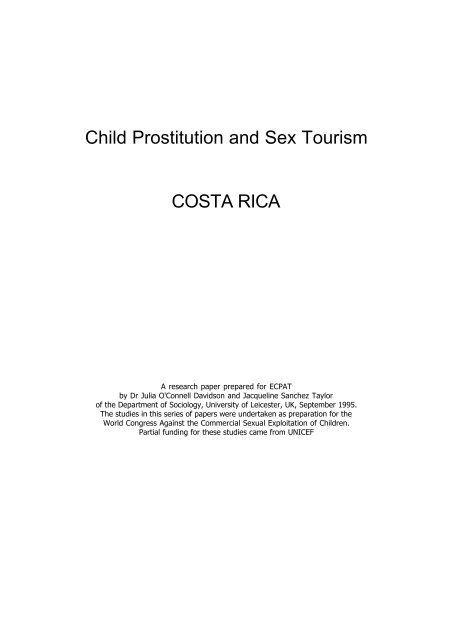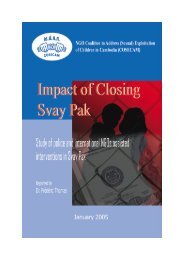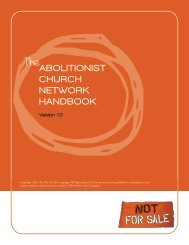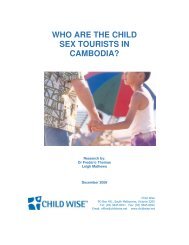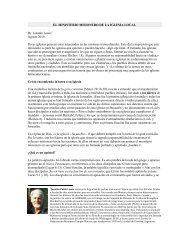Child Prostitution and Sex Tourism COSTA RICA - Consortium for ...
Child Prostitution and Sex Tourism COSTA RICA - Consortium for ...
Child Prostitution and Sex Tourism COSTA RICA - Consortium for ...
You also want an ePaper? Increase the reach of your titles
YUMPU automatically turns print PDFs into web optimized ePapers that Google loves.
<strong>Child</strong> <strong>Prostitution</strong> <strong>and</strong> <strong>Sex</strong> <strong>Tourism</strong><strong>COSTA</strong> <strong>RICA</strong>A research paper prepared <strong>for</strong> ECPATby Dr Julia O'Connell Davidson <strong>and</strong> Jacqueline Sanchez Taylorof the Department of Sociology, University of Leicester, UK, September 1995.The studies in this series of papers were undertaken as preparation <strong>for</strong> theWorld Congress Against the Commercial <strong>Sex</strong>ual Exploitation of <strong>Child</strong>ren.Partial funding <strong>for</strong> these studies came from UNICEF
This series of research papers has been published by ECPAT as background documents <strong>for</strong> the World Congress Against theCommercial <strong>Sex</strong>ual Exploitation of <strong>Child</strong>ren, August 1996. Case studies are based on authors' interviews. Names of thoseinterviewed have been changed in all cases.Papers in this series:1. <strong>Child</strong> <strong>Sex</strong>ual Exploitation in Costa Rica2. <strong>Child</strong> <strong>Prostitution</strong> <strong>and</strong> <strong>Sex</strong> <strong>Tourism</strong> in Cuba3. <strong>Child</strong> <strong>Prostitution</strong> <strong>and</strong> <strong>Sex</strong> <strong>Tourism</strong> in the Dominican Republic4. <strong>Child</strong> <strong>Sex</strong>ual Exploitation in Goa5. <strong>Child</strong> <strong>Sex</strong>ual Exploitation in Venezuela6. <strong>Child</strong> <strong>Prostitution</strong> <strong>and</strong> <strong>Sex</strong> <strong>Tourism</strong> in South Africa7. <strong>Sex</strong> <strong>Tourism</strong> in Pattaya, Thail<strong>and</strong>© Julia O'Connell Davidson <strong>and</strong> Jacqueline Sanchez Taylor, 1996Published by:ECPAT International326 Phaya Thai RoadBangkok 10400THAILANDTel: 662 215 33 88Fax: 662 215 82 72
INTRODUCTIONCosta Rica is widely perceived as Latin America's most stable <strong>and</strong> affluent democracy. This relative judgmentshould not deflect from the fact that the country's economy has been under serious pressure since the late 1970s.Costa Rica's manufacturing industries have always been heavily dependent on <strong>for</strong>eign investment <strong>and</strong> its welfarestate <strong>and</strong> much of its industrial infrastructure was financed through <strong>for</strong>eign loans.Export earnings from the coffee <strong>and</strong> bananas industries should have allowed Costa Rica to support this debt, butin 1978 coffee prices collapsed <strong>and</strong> the following year oil prices rocketed. By 1981, Costa Rica's national <strong>for</strong>eigndebt had reached US$4 billion, <strong>and</strong> it became the first country to suspend repayments on international loans.In the early 1980s, inflation dramatically reduced real wages <strong>and</strong> under pressure from the International MonetaryFund (IMF) the government embarked on a sustained programme of austerity measures, dismantling much of thewelfare provision that had previously distinguished Costa Rica from its Latin American neighbours (Barry, 1991).Today, Costa Rica's international debt st<strong>and</strong>s at around US$3.5 billion, real wages remain stagnant <strong>and</strong> 10% ofthe county's 2.9 million people are living in absolute poverty. This is a country which desperately needs <strong>for</strong>eignexchange revenue, <strong>and</strong> like many other countries in the same position it has developed its tourist industry inpursuit of hard currency. <strong>Tourism</strong> has now overtaken the banana industry as Costa Rica's most important sourceof <strong>for</strong>eign exchange.Though the Government <strong>and</strong> tourist authorities like to highlight the development of so-called Eco-tourism (thecountry won an award <strong>for</strong> its 'exemplary support' of ecologically responsible tourism in 1992 - Baker, 1993),Costa Rica actually hosts large numbers of dedicated, seasoned North American <strong>and</strong> European sex tourists.Meanwhile, it seems probable that many of the male tourists who are ostensibly drawn to Costa Rica <strong>for</strong> otherreasons (surfing, water sports, ecotourism, etc.), as well as some of the 30,000 US citizens who have retired toCosta Rica, also sexually exploit local women <strong>and</strong> children during the course of their stay.A few statistics baldly explain why many Costa Rican women <strong>and</strong> children are so vulnerable to this <strong>for</strong>m ofexploitation. In addition to the fact that 10% of Costa Ricans live in absolute poverty, it is the case that 40% offemale adolescents do not attend school <strong>and</strong> 28% of youths between the ages of 12 <strong>and</strong> 19 work as domestics <strong>for</strong>below poverty level wages (Agustin Castro, 1994).Furthermore, despite the fact that children are legally sexual minors until the age of 18, some 25% of CostaRican mothers have their first child between the ages of 15 <strong>and</strong> 18; <strong>and</strong> 41% of births are to single mothers(Barry, 1991). There is also a serious drug problem in Costa Rica, which both reflects <strong>and</strong> compounds the miseryassociated with poverty. For many women <strong>and</strong> children, this is an economic <strong>and</strong> social context in which the onlything they can hope to sell, barter or exchange is their own bodies <strong>and</strong> sexuality.This report looks at the different ways in which Costa Rican women <strong>and</strong> children are sexually exploited <strong>and</strong> atthe identity <strong>and</strong> motivations of the men who purchase sexual access to them. It is based on seven days offieldwork in San Jose, Puerto Limon <strong>and</strong> Cahuita, <strong>and</strong> is particularly concerned with links between tourism <strong>and</strong>sexual exploitation.Be<strong>for</strong>e moving on to substantive issues, some methodological issues are briefly discussed, <strong>and</strong> these should beborne in mind throughout the rest of the report.
METHODOLOGICAL ISSUESFieldwork in Costa Rica was undertaken by Julia O'Connell Davidson <strong>and</strong> Jacqueline Sanchez Taylor in August1995 <strong>and</strong> the data upon which this report is based has two key limitations. First, it was collected over a veryshort period of time, <strong>and</strong> second, it was collected during low season.Since we had only seven days <strong>and</strong> nights in which to work, there were many 'leads' which we were unable to pursue<strong>and</strong> many places we were unable to visit, <strong>and</strong> because it was low season the sample of sex tourists available toobserve <strong>and</strong> interview was very small. Only 10 in-depth interviews (one hour plus) <strong>and</strong> six short interviews (lessthan one hour) with sex tourists <strong>and</strong> 'sexpatriates' were achieved.We attempted to compensate <strong>for</strong> this in a number of ways:• by interviewing prostitutes <strong>and</strong> others working in the <strong>for</strong>mally organised sex industry;• by interviewing Costa Ricans <strong>and</strong> North Americans working in the tourist trade;• by visiting slum areas <strong>and</strong> interviewing women <strong>and</strong> children living in them;• by obtaining data from other sources, in particular, newspaper cuttings about child sexual exploitation.It was also possible to consider <strong>and</strong> compare the interview material from sex tourists <strong>and</strong> sexpatriates in CostaRica against that obtained from a far greater sample of such men collected on research trips to Thail<strong>and</strong> <strong>and</strong>Cuba, which we believe makes the analysis provided below more reliable, despite being based on a relatively smallsample.However, the reader should keep the following three points in mind when assessing the in<strong>for</strong>mation provided inthis report:1. The fact that it was low season when we visited meant that expatriates were more visible <strong>and</strong> more accessible<strong>for</strong> interview than they would be in high season. In one sense, we believe that this was <strong>for</strong>tuitous, since sexualexploitation by such men in economically underdeveloped countries is generally under-researched even though itis widely suspected that there are many preferential child abusers among their ranks.In another sense, however, it meant that our data was skewed, highlighting sexual exploitation by this groupmore clearly than that perpetrated by tourists. In<strong>for</strong>mation about tourists to the Caribbean coast's practice oftaking very young 'girlfriends', <strong>for</strong> example, was provided by local people <strong>and</strong> the girls themselves <strong>and</strong> could notbe fleshed out by interview material from men who personally admitted to such activities.Likewise, our sample of 'situational' sex tourists was inadequate, <strong>and</strong> we feel able to advance only generalisationson the basis of it because we have interviewed larger numbers of such men elsewhere in the world.2. Most of the evidence on organised child prostitution that is presented in this report comes from secondarysources: it is based on news reports of police raids, trials <strong>and</strong> research by other organisations, references <strong>for</strong> whichare provided at the end of this report.3. In any country in the world, it is virtually impossible to obtain reliable data on the numbers of people workingas prostitutes. Even where prostitution is legal <strong>and</strong> official data is collected, official figures will not includechildren or illegal migrants working as prostitutes, <strong>and</strong> in countries which host sex tourists there are also manywomen <strong>and</strong> children who exchange sexual access to their persons <strong>for</strong> money or goods, yet do not definethemselves as prostitutes.Moreover, many adults <strong>and</strong> children use prostitution as a temporary solution to economic problems <strong>and</strong> thusmove in <strong>and</strong> out of the prostitution 'labour market', so that even if it were possible to obtain a 'snap shot' figureof the numbers of people working as prostitutes at any given moment in time, it would not necessarily reflect thetrue number of people who are vulnerable to this <strong>for</strong>m of sexual exploitation.It is still more difficult to obtain reliable data on the numbers of men (<strong>and</strong> women) who use prostitutes or enterinto other sexually exploitative relationships.
Our research was concerned to discover the <strong>for</strong>ms which the sexual exploitation of children can take in CostaRica <strong>and</strong> to explore the motivations <strong>and</strong> attitudes of Western men who practice sex tourism there.It did not attempt to measure the scale of the problem of child prostitution in Costa Rica, nor to producenumerical data on the numbers of sex tourists <strong>and</strong> expatriates involved in the sexual exploitation of childrenthere. Other sources suggest that prostitution is a major economic sector in Costa Rica. It is estimated, <strong>for</strong>example, that there are more than 300 brothels in San Jose alone (Gonzlez Mora, 1995).If we assumed that each brothel organised the sexual 'labour' of 10 females - a very conservative estimate - thiswould mean that around 3,000 women <strong>and</strong> girls are <strong>for</strong>mally employed as prostitutes in a city with an officialpopulation of only 278,373 people; in other words, that some 1.1% of San Jose's entire population may be beingprostituted in brothels.As a percentage of San Jose's population of females between the ages of, say, 15 <strong>and</strong> 30, this figure would lookeven more disturbing, <strong>and</strong> if it were possible to add the number of women <strong>and</strong> girls who are prostituted by smalltime pimps <strong>and</strong> those who prostitute themselves independently, then the percentage of women <strong>and</strong> girls in CostaRica who are sexually exploited at some point in their lives would look quite staggering.This, alongside our own observations <strong>and</strong> interviews, makes us confident about claiming that prostitution ingeneral is a sizeable phenomenon in Costa Rica.So far as the sexual exploitation of children is concerned we cannot with certainty advance any claims about thenumbers involved. All we can say with confidence is that it happens <strong>and</strong> that there are tourists <strong>and</strong> expatriateswho are guilty of sexually exploiting <strong>and</strong> sexually abusing children in Costa Rica. We believe that this, in itself,should be enough to prompt concern <strong>and</strong> action.Notes on terminologyThe report sometimes refers to Costa Ricans as 'Ticans', a term used by many local people <strong>and</strong> tourists.Where the term 'underage' is used, it refers to those deemed sexual minors in Costa Rica, i.e. under 18 year olds.Costa Rica's currency is the colon, <strong>and</strong> is referred to with a 'c' in this report. The exchange rate at the time of ourresearch was 177c to one US dollar.
SEXUAL EXPLOITATION IN <strong>COSTA</strong> <strong>RICA</strong>In Costa Rica, men are presented with opportunities to purchase sexual access to women <strong>and</strong> children in severaldifferent ways <strong>and</strong> sexual exploitation thus takes a variety of <strong>for</strong>ms, each of which involves the exploited partyin different types of relationships with her or his exploiter or exploiters. Three distinct modes of organisingsexual access are outlined here.1. Independent <strong>Prostitution</strong>The women <strong>and</strong> children in Costa Rica who prostitute themselves independently are not a homogeneous groupeither in terms of the conditions of their work or the material benefits they derive from it. Rather there is acontinuum of experience, with relatively successful, self assured adult women who may charge men up to US$100per night <strong>for</strong> sexual services at one pole, <strong>and</strong> drug addicted children who, from the age of eight upwards, exchangesexual access to their bodies <strong>for</strong> less than 500c (US$2.50) at the other.There are a number of bars <strong>and</strong> casinos in San Jose from which successful independent prostitutes work. The bestknown of these is a bar which caters primarily to tourists. A guidebook written by a sex tourist <strong>for</strong> sex touristsdescribes it as 'certainly the best bar in all of San Jose <strong>for</strong> American men' (Cassirer, 1992:75). The bar benefitsfinancially from prostitution by charging men an entrance fee of 500c <strong>and</strong> selling drinks <strong>and</strong> food (as well asclothing <strong>and</strong> gifts from a small shop) at hugely inflated prices, rather than by directly organising the work ofprostitutes.Other venues favoured by more successful independent prostitutes are the casinos in smart hotels owned by large,international conglomerates. The women who solicit in such places are generally in their early twenties <strong>and</strong> theyare smartly dressed <strong>and</strong> look well fed. Not all work as prostitutes full time. A few have an income from another<strong>for</strong>m of employment <strong>and</strong> use prostitution only as a means of topping it up as <strong>and</strong> when necessary.The degree of control that such women exercise over transactions with clients is directly related to how muchthey are in need of money. The less desperate they are <strong>for</strong> cash, the greater their choice in relation to when t owork <strong>and</strong> <strong>for</strong> how long, what price to accept, what to provide in exchange <strong>for</strong> a given sum.Because they have not entered into any contractual obligations to a third party employer, it is economiccompulsion alone which controls the details of their work. If they are doing well, they can af<strong>for</strong>d to turn downthe advances of men who, <strong>for</strong> whatever reason, they do not want to do business with.Only a minority of autonomous prostitutes are in a position to charge US$100 per night, or enjoy this type ofcontrol, however. Maria, a woman we interviewed in Puerto Limon, is probably more typical of independentadult prostitutes in Costa Rica.Maria is 45 <strong>and</strong> has six grown up children <strong>and</strong> a three year old gr<strong>and</strong>child who lives with her. Her husb<strong>and</strong> wasparalysed in an accident ten years ago <strong>and</strong> receives a pension of 8,OOOc (about US$45) per month. Unless Mariaprostitutes herself, this pension is the household's only income since she can find no other paid work.Like many women <strong>and</strong> teenagers in a similar position, Maria solicits five or six nights a week in a bar in thecentre of Limon which has rooms <strong>for</strong> hourly rent upstairs. If she is successful in attracting a client, she pays thebar 200c <strong>for</strong> use of a room.Independent prostitutes working in this way end up with as little as 800c once they have paid rent on the room.On Tuesdays, Filipino, Jamaican <strong>and</strong> Argentinean ships dock in Puerto Limon <strong>and</strong> sailors come ashore. Prostitutewomen <strong>and</strong> children aged from 11 <strong>and</strong> 12 upwards then flock to the bars near the docks in order to sellthemselves to the sailors. <strong>Child</strong>ren generally offer 'blow jobs' <strong>for</strong> 300c, adult women try to persuade men to pay2,OOOc <strong>for</strong> penetrative sex.Although a certain number of tourists stop in Limon <strong>for</strong> a few days on their way through to the popular touristbeach towns of Cahuita <strong>and</strong> Puerto Viejo, the majority of clients of these women <strong>and</strong> children are local men <strong>and</strong>sailors. The situation of women <strong>and</strong> children who independently prostitute themselves in places such as the slumareas of San Jose is equally bleak.We visited one such area known as Los Cuadros. In this shanty town, mothers (many of whom are themselvesonly 13 or 14 years old) struggle to look after babies <strong>and</strong> young children in cramped <strong>and</strong> rotting hovels known as
ancheros, many of which are without any <strong>for</strong>m of sanitation. Households of five people <strong>and</strong> more are lucky t ohave one bedroom <strong>and</strong> two beds.Although Costa Rican children are <strong>for</strong>mally entitled to free education up to the age of 18, there are no schools inthis barrio, <strong>and</strong> the nearest primary school is some four or five kilometers away. Mothers told us that they didnot take their children to this school because they did not have the money to buy shoes or decent clothing <strong>for</strong>themselves or their children <strong>and</strong> were ashamed to leave the barrio.In good weather children 'hang out' on the roadside outside their homes. In the rainy season, when the rancherosare surrounded by sewage-filled mud, they crowd inside where the rainwater pours onto dirt floors through gaps inthe corrugated iron roofs.The incidence of sexual <strong>and</strong> physical abuse within the family is believed to be high in such areas <strong>and</strong> young girlsare often desperate to escape from their parents. Three of the women we interviewed in Los Cuadros said that ata young age they had run away from parental abuse with their boyfriends. They had then become pregnant <strong>and</strong>their boyfriends had left them so that, at the age of 13, they had found themselves single mothers.There are only three possible sources of income <strong>for</strong> girls in this situation - prostitution, domestic work whichoften also entails sexual exploitation (see below) <strong>and</strong> selling lottery tickets. Many women <strong>and</strong> girls from therancheros combine all three: selling lottery tickets <strong>for</strong> a pathetic commission to men <strong>and</strong> women like themselveswho draw com<strong>for</strong>t from the dream that fate will suddenly deliver them from poverty (this despite knowing thatthe cheap lottery is invariably being worked as a scam further up the line); working as maids <strong>for</strong> as many hoursper week as they can find at an hourly rate of between 150 <strong>and</strong> 200c, <strong>and</strong> going on the streets of Los Cuadros atnight to sell sexual access <strong>for</strong> as little as 300c.Their clients are local men <strong>and</strong> prostitutes exercise so little control within the transaction that few of them caneven insist on the use of condoms. Girls are frequently impregnated by their clients as well as exposed to the riskof AIDS <strong>and</strong> other sexually transmitted diseases. It is not uncommon to find women who, by the age of 18,already have three children, one or two of whom have been sired by clients.We have been describing the kind of independent prostitution which takes the <strong>for</strong>m of explicit <strong>and</strong> fairlynarrowly defined contractual exchanges (i.e., x colones in return <strong>for</strong> x services or x hours of access to theperson). But sex tourists <strong>and</strong> expatriates do not always secure sexual access to Costa Rican women <strong>and</strong> childrenby entering into overt commercial transactions. They can also obtain this access by picking a 'girlfriend' fromthe ranks of teenage girls <strong>and</strong> adult women who are willing to enter into non-contractual relationships with<strong>for</strong>eign men living or holidaying in Costa Rica.Such relationships are modelled along the lines of non-commercial, romantic relationships <strong>and</strong> although the girlor woman usually hopes to secure some material benefit from the sex tourist (which could be marriage <strong>and</strong> thus away out of Costa Rica, or could be simply gifts <strong>and</strong>/or money), she will rarely explicitly negotiate or dem<strong>and</strong> anysuch benefit. The man may spend a night, a week, a month, possibly longer with the woman or girl, <strong>and</strong> the'payment' he provides her is entirely at his whim.Some men lavish gifts upon their 'girlfriends', others give money, some give nothing more than a few drinks at abar.Those who are sexually exploited in this way do not typically view themselves as prostitutes, nor are theygenerally considered to be prostitutes by tourists or by their fellow Costa Ricans, who make a linguisticdistinction between putas <strong>and</strong> Zorro’s .The term putas is applied to brothel <strong>and</strong> street prostitutes, whilst zorra, which literally translates as 'fox', is usedin much the same way as the term jinitera is used in Cuba, namely to refer to girls <strong>and</strong> women who enter into lessexplicitly contractual sexual arrangements with tourists.As ever, the degree of control that a woman or girl exercises within such a relationship correlates with the degreeof her economic desperation. It seems probable that even during high season, the supply of zorras outstrips thedem<strong>and</strong> <strong>for</strong> them, <strong>and</strong> that their bargaining position is there<strong>for</strong>e always weak.Meanwhile, since many sex tourists value such arrangements precisely because they are non-contractual, it willalways be difficult <strong>for</strong> the 'girlfriend' to clearly set the terms of the transaction except through resort to
subterfuge <strong>and</strong> her ability to manipulate a 'boyfriend' to her own advantage will thus largely depend on her age,experience <strong>and</strong> wit.Numerous zorras are to be found at the beach <strong>and</strong> surfing holiday destinations on both the Caribbean <strong>and</strong> Pacificcoasts. We visited one such place - a small town named Cahuita on the Caribbean coast. Cahuita has an officialpopulation of 3,000 <strong>and</strong> like other such towns it is completely economically dependent on tourism. 1During the high season, the town throngs with tourists, <strong>and</strong> girls from the surrounding region congregate in itsbars <strong>and</strong> its one main disco in search of European or North American 'boyfriends'. It is clearly understood bylocals <strong>and</strong> tourists alike that the majority of these zorras hope to get money or gifts from tourists <strong>and</strong> that manyhave dependent children whom they seek to support in this way.A large proportion of zorras are believed to be under the age of 18 <strong>and</strong> some are as young as 12 years old.Despite the fact this makes them sexual minors, the Costa Ricans we interviewed said that a girl who has reachedphysical maturity (often demonstrated in the fact she had given birth) is generally seen as an adult by localpeople, even if she is only 12 or 13 years old, <strong>and</strong> thus child zorras are neither viewed as prostitutes or aschildren.A 23 year old woman in Cahuita who told us that she herself had had numerous relationships with tourists overthe past ten years <strong>and</strong> hoped one day to find an American or Canadian who would marry her commented:A lot of old men come here looking <strong>for</strong> young girls. Girls of 12 <strong>and</strong> 13 have Italian <strong>and</strong> Americanboyfriends...Girls of my age <strong>and</strong> younger get married to men of 60. One girl married a man of 70...No-one cares about age in Costa Rica, if it's an old man with a very young girl, that's just normal.Age difference doesn't matter.As well as picking up zorras in beach resorts <strong>and</strong> towns, <strong>for</strong>eign men make use of the personal columns in CostaRican English language newspapers to find themselves 'girlfriends' <strong>and</strong> wives. The following advertisement isfairly typical:Single, white male (divorced 8 years) planning to move to Costa Rica in the next few months. Iwould like to meet a marriage minded woman between the ages of 20 <strong>and</strong> 30 who is very attractive:trim <strong>and</strong> speaks some/good English. I am considered h<strong>and</strong>some: age 47; weigh 195 lbs, <strong>and</strong> 5ft llin,tall. Send letter with recent color photo... (The Tico Times, August 11, 1995).2. Direct Forms of Third Party InvolvementNot all prostitutes work independently. Many enter into some kind of employment relation with a third partywho directly organises <strong>and</strong> controls their work. 'Free choice' adult prostitution is legal in Costa Rica <strong>and</strong> thecountry has a well developed, organised sex industry within which sexual access is fully <strong>and</strong> explicitlycommodified. Costa Rican law seeks to regulate <strong>and</strong> control prostitution as an industry, especially as regards theage of both clients <strong>and</strong> prostitutes, who must be over 18 years of age.Providing a brothel-keeper employs women of 18 or over <strong>and</strong> hires doormen to check the age of customersbe<strong>for</strong>e allowing them entry, it is there<strong>for</strong>e legal to run highly visible brothels, openly recruiting women to workin them <strong>and</strong> freely advertising their 'services' <strong>and</strong> there are some brothels <strong>and</strong> massage parlours in San Jose whichoperate within this legal framework. We visited one such establishment in San Jose's red light district <strong>and</strong>interviewed its doorman <strong>and</strong> manager.It is situated in a two-storey building. On the ground floor is a darkened bar with music <strong>and</strong> television screensshowing pornographic videos <strong>and</strong> behind this is a room that is not open to customers which serves as a kind ofcommon room <strong>for</strong> the 'girls'. Upstairs are a number of small cubicle-like rooms in which men are 'serviced'. Threedoormen st<strong>and</strong> on the street outside, touting <strong>for</strong> business, checking the ID of younger looking clients <strong>and</strong> takingentrance fees (400c per person).The brothel is open from 2 p.m. to 2 a.m. daily <strong>and</strong> prostitutes generally work as many 12 hour shifts per weekas management requires or allow them. There are 25 prostitutes working on each shift <strong>and</strong> they are paid on a perpiece basis rather than receiving an hourly wage from their employer. In this way they are 'incentivised' tocompete with each other to solicit custom from the men drinking at the bar.
Once a customer has selected a woman, he must pay the bar 800c to take her upstairs <strong>and</strong> pay the woman2,OOOc <strong>for</strong> a half hour 'session'. The doormen estimate that somewhere between 350 <strong>and</strong> 500 men visit daily<strong>and</strong> labour costs are low (only the five bar staff, the doormen <strong>and</strong> the manager are on a regular wage <strong>and</strong> the mosthighly paid of these receives only 16,OOOc per week), so the brothel represents a relatively lucrative business.Its owner is clearly doing well (he owns two other similar establishments) <strong>and</strong> his manager claims that it wouldnot be worth risking this business by breaking the law to allow under-age prostitutes to work in the brothel.Despite the porn videos, small upstairs rooms <strong>and</strong> large throughput of clients, this brothel is almost a 'classy'establishment by comparison with other legally run brothels in San Jose, some of which issue clients withnumbered tickets on arrival <strong>and</strong> seat them in rows to wait <strong>for</strong> their number to be called, at which point they go toa cubicle to spend no more than 15 minutes with the prostitute who has called them. A supervisor will go <strong>and</strong> callthem out if they attempt to overstay this time limit. Whether they be 'classy' or 'tacky' however, it seems thatthe owners of successful <strong>and</strong> visible brothels do have a certain incentive to keep within the law as regards the ageof the prostitutes they exploit. The police do sometimes run checks on the age <strong>and</strong> immigration status 2 ofprostitutes working in such establishments, <strong>and</strong> prosecution could lead to the establishment being closed down <strong>for</strong>a period of time, thus interfering with the stream of income from it.Not all brothels are either so visible or so commercially successful. Many are disguised as massage parlours,hairdressers, bars or hotels (Gonzalez Mora, 1995) <strong>and</strong> it is in these more concealed establishments that childprostitutes <strong>and</strong> illegal migrants are more likely to be found, as a number of police raids on night clubs <strong>and</strong> bars inSan Jose over the past two years has shown. It is also known that there are bars which covertly organise childprostitution <strong>for</strong> a tourist market <strong>and</strong> even produce catalogues of child prostitutes <strong>for</strong> their clients (AgustinCastro, 1994).It seems reasonable to assume that owners of visible but unsuccessful brothels are more likely to break the lawssurrounding under-age prostitution since they have less at risk. The closure of a bar or brothel with a poorturnover is not so great a threat <strong>and</strong> legal sanctions against individuals who are caught organising the sexualexploitation of children can hardly be described as a deterrent. A bar owner arrested in 1994 <strong>for</strong> running a childprostitution ring involving 17 children (to whom he was also supplying glue) recently paid just 10,000c to ensurehis freedom (Prensa Libre, 1995).Some brothels rely primarily on business from tourists <strong>and</strong> expatriates living in Costa Rica. One brothel isreckoned by its manager to serve a clientele that is 80% tourists <strong>and</strong> to get repeat business from <strong>for</strong>eign men.Although there are sex tourists who explicitly prefer <strong>and</strong> repeatedly seek out seamy, dirty brothels, they are in adistinct minority <strong>and</strong> the less visible, seedier brothels in poorer areas of San Jose <strong>and</strong> other cities <strong>and</strong> tourist spotsthere<strong>for</strong>e rely predominantly upon local custom (in port towns, such brothels also serve sailors).Prices, <strong>and</strong> so 'business' turnover, vary accordingly <strong>and</strong> this has implications <strong>for</strong> the prostitution 'labour market'.It is more difficult <strong>for</strong> under-age girls to find work in the 'classier' brothels that cater to <strong>for</strong>eign dem<strong>and</strong>, so thefact that some adult women prostitutes earn relatively good money in such establishments does not strengthenyounger girls' bargaining position.It follows from all this that prostitutes who enter into direct or indirect employment relations with brothel, bar,parlour, hotel or night-club owner are not a homogeneous group in terms of the conditions of their work or thefinancial benefits they derive from it.There is, effectively, a two tier labour market within the organised sex industry with a small 'elite' group ofwomen aged between 18 <strong>and</strong> 24 who service wealthier clients <strong>and</strong> enjoy relatively good earnings (although byEuropean <strong>and</strong> North American st<strong>and</strong>ards their work is extremely dem<strong>and</strong>ing in terms of the number of men theymust service each day) <strong>and</strong> a much larger group of prostitutes who are intensively exploited both economically<strong>and</strong> sexually. This latter group includes under-age girls as well as older women <strong>and</strong> those in their late teens <strong>and</strong>early twenties who are either less conventionally attractive or less well dressed or simply less <strong>for</strong>tunate thanthose who work in the brothels that cater primarily to tourist dem<strong>and</strong>.Some prostitutes are financially <strong>and</strong> sexually exploited by a pimp who organises <strong>and</strong> controls their 'labour' ratherthan by a brothel, bar or massage parlour owner or a hotelier. Such arrangements are more in<strong>for</strong>mal <strong>and</strong> thedegree of exploitation suffered by the prostitute varies upon the whim of the pimp <strong>and</strong>/or the extent to which heis able to control <strong>and</strong> manipulate her/him. In Costa Rica, as elsewhere in the world, there are men who abuse theireconomic <strong>and</strong> social power over wives <strong>and</strong>/or daughters to <strong>for</strong>ce them into prostitution.
One married prostitute in Limon told us that her husb<strong>and</strong>, a crack addict, sometimes wakes her in the night inorder to 'give' her to a client he has brought home. While she is 'servicing' the client her husb<strong>and</strong> is out spendingthe pre-paid price of access to her body. Such stories are not uncommon.Crack dealers also exercise a great deal of power over the addicts that depend on them <strong>for</strong> a supply of drugs,many of whom are children. One crack addicted child prostitute told us that her dealer gives her a single 'rock' ofcrack (with a street value of 500c) if she grants sexual access to men that the dealer takes her to. The men paythe dealer rather than the child <strong>and</strong> it seems likely that they pay him a good deal more than he has paid <strong>for</strong> thedrugs he gives the child.Jose, a young man currently undergoing drug rehabilitation in Puerto Limon, told a similar story. He is 25 yearsold. He had been addicted to glue, heroine, cocaine <strong>and</strong> later crack since the age of eight; in other words, <strong>for</strong> 17years. At first he lived in a slum district of Limon with his parents, but from the age of 12 he had been living onthe streets. He was sexually abused by drug dealers who also 'sold' him to other men <strong>and</strong> later he prostitutedhimself independently to support his habit.He told us that most of the clients of drug addicted children are local men or sailors. He believed that localdem<strong>and</strong> <strong>for</strong> young boys arises because homosexuality is heavily stigmatised in Costa Rica, so 'respectable' CostaRican men prefer to pick up boys from the street <strong>and</strong> take them somewhere discreet to use them rather than toenter into open homosexual relationships with their social <strong>and</strong>/or age equals.Jose claimed that street children are also sometimes sexually exploited by tourists <strong>and</strong> expatriates (sometimesover a period of days or weeks) who pay pimps to procure them. It seems highly probable that <strong>for</strong>eign men wouldrequire the services of a pimp to secure access to street <strong>and</strong> slum children, <strong>for</strong> even sex tourists with apredilection <strong>for</strong> 'low-life' value their own personal safety <strong>and</strong> no tourist would feel that this was assured in an areasuch as Los Cuadros, <strong>for</strong> example.There is, however, some evidence that expatriate paedophiles with 'good' connections in Costa Rica can organisetheir own child prostitution <strong>and</strong> pornography rings <strong>and</strong> this may also be drug related with the expatriateexploiting the child's dependence on crack in order to draw him or her into a relationship within which the adultcan act as pimp.A Costa Rican organisation, Unidad Preventiva del Delito, has uncovered one paedophile network based fromproperty in Puntarenas owned by two Americans <strong>and</strong> in the space of only three months between September <strong>and</strong>November 1992, police in Puntarenas uncovered five similar establishments where minors were taken <strong>for</strong> sex(Aguilar, 1994).3. Indirect Forms of Third Party InvolvementAs well as third parties who directly organise the work of prostitutes in brothels, there are a number of ways inwhich third parties benefit financially from various <strong>for</strong>ms of sexual exploitation without becoming directlyinvolved in arranging the details of sexual transactions.There are numerous mail order bride, dating <strong>and</strong> escort agencies which profit from various types of prostitutionwithout actually setting the price or limits of the prostitute-client exchange. Such agencies often advertise in theTico Times, an English language newspaper aimed at expatriates <strong>and</strong> tourists. The following is one example ofsuch adverts:DREAMGIRLS!...Beautiful, sweet, loving, traditional, nice Costa Rican girls all ages, interested in meeting &corresponding with nice older guys, all ages. If you are serious about finding a Costa Rican dream girl,we can make your dream come true. We have incredible references(Tico Times, August 11, 1995).
Sometimes there are several layers of individuals <strong>and</strong> companies which are parasitic on a group of prostitutes'sexual exploitation. The <strong>for</strong>eign owner of a San Jose bar does business with a US based company selling 'eroticholidays' to Costa Rica. He allows the company to use his Internet address in exchange <strong>for</strong> a commission <strong>and</strong>passes details of the clients who contact him on to a Costa Rican run company which then arranges sexual accessto Costa Rican women <strong>for</strong> them (Mora, 1995).Agencies which recruit <strong>and</strong> supply domestic servants often represent another <strong>for</strong>m of indirect third partyinvolvement in sexual exploitation, especially the exploitation of children. Domestic service is a major <strong>for</strong>m offemale <strong>and</strong> child employment in Costa Rica. In 1992, 28% of youths between the ages of 12 <strong>and</strong> 19 wereworking as domestics.Domestic work is not regulated in terms of hours or wages <strong>and</strong> what little legislation there is is ignored byemployers <strong>and</strong> agencies (Agustin Castro, 1994). Historical <strong>and</strong> contemporary evidence shows that domesticservants are particularly vulnerable to sexual harassment, exploitation <strong>and</strong> abuse by males in the households inwhich they work <strong>and</strong> this certainly appears to be the case in Costa Rica. The attitude of Costa Rican men towardssuch women was well captured by a taxi driver who told us that the girls from Los Cuadros who work as domesticscharge 150c per hour <strong>and</strong> <strong>for</strong> this sum will 'clean <strong>for</strong> you, sleep with you or rob you if you don't keep your eye onthem'.The system of domestic service is also a means through which <strong>for</strong>eigners obtain sexual access to girls <strong>and</strong> boys.Regular tourists to Costa Rica do not always stay in hotels but often prefer to rent private apartments, as do themany American <strong>and</strong> Canadian retirees in Costa Rica.Tourists <strong>and</strong> expatriates generally favour apartments in purpose built complexes that are owned by a l<strong>and</strong>lord oragency which provides property services, such as the maintenance of buildings, swimming pools, gardens <strong>and</strong>security. Such agencies also typically provide each apartment with a maid <strong>and</strong> this service is often a thinly veiled<strong>for</strong>m of procuring.<strong>Sex</strong> tourists tell of agencies which invite them to select a 'maid' by looking through folders of colour photographsof the girls on offer <strong>and</strong> tell them they can change their maid <strong>for</strong> a small fee. Meanwhile, the system of 'maiding'makes various <strong>for</strong>ms of sexual abuse into very low risk crimes.Such abuse takes place within the privacy of the abuser's own home <strong>and</strong> children who are financially dependenton an on-going basis to the same man (or agency) are unlikely to put their job at risk by denouncing their abusers(Agustin Castro, 1994).
TYPES OF DEMAND FOR SEXUAL ACCESSTO WOMEN AND CHILDREN1. Local dem<strong>and</strong>There is substantial local dem<strong>and</strong> <strong>for</strong> both adult women <strong>and</strong> child prostitutes in Costa Rica. We were unable t ointerview Costa Rican clients, <strong>and</strong> can there<strong>for</strong>e only analyse this dem<strong>and</strong> through reference to in<strong>for</strong>mationprovided by prostitutes <strong>and</strong> our more general observation of attitudes towards class, gender <strong>and</strong> sexuality in CostaRica. On the basis of this, we would suggest that three factors may be particularly significant to any explanationof local dem<strong>and</strong> <strong>for</strong> child prostitutes.To begin with there are cost considerations. Because 'classier' brothels in San Jose's red light district are relativelyexpensive, this type of prostitution is outside the reach of most working class <strong>and</strong> poor Costa Rican men whocould not af<strong>for</strong>d to pay $100 a night to the independent prostitutes who work from the smarter, tourist-orientedbars <strong>and</strong> casinos. Low rent brothels (which are more likely to employ under-age prostitutes) <strong>and</strong> independentstreet prostitutes (including children from the age of nine upwards) in poorer districts represent a cheaperalternative.It is not only working class <strong>and</strong> poor Costa Rican men who frequent prostitutes however. Wealthy Costa Ricansare to be found in better class brothels. It seems likely that local dem<strong>and</strong> <strong>for</strong> prostitutes, just as much as touristdem<strong>and</strong>, is strongly related to popular attitudes towards gender <strong>and</strong> sexuality <strong>and</strong> to the set of ideas embodied inthe concept of machismo.For macho men the world over, penetrating or being fellated by multiples of females is seen as affirmative ofmasculinity, <strong>and</strong> prostitution provides an unchallenging, quick route to this kind of affirmation.Though Costa Rica is a more secular country than most of its Latin American neighbours, around 90% of itspopulation is officially Roman Catholic <strong>and</strong> the distinction between 'Madonnas' <strong>and</strong> 'whores' that is promulgatedby Catholicism (as well as being central to many other religions) still appears to in<strong>for</strong>m the Costa Ricanimagination.A song taught to school children captures the essence of what is expected of wives <strong>and</strong> mothers:I want to get married to a lady in the city Someone who knows how to sweep Who knows how toclean Who knows how to open the door so I can go out to work And who knows how to cook ricepudding.'Whores', on the other h<strong>and</strong>, provide opportunities <strong>for</strong> the indiscriminate, anonymous, serial expression of'manhood'. Although we have no systematic evidence to support this view, we would suggest that it is theindiscriminate nature of such clients' sexuality which provides a second possible explanation <strong>for</strong> local dem<strong>and</strong> <strong>for</strong>child prostitutes.Accounts of clients' attitudes <strong>and</strong> behaviour provided by both adult <strong>and</strong> child prostitutes suggest that many menquite simply do not care whom they have sexual intercourse with. It is the activity, rather than its object, whichis valued.Support <strong>for</strong> this hypothesis also comes from observation of prostitutes in poorer areas, <strong>for</strong> most are far fromany idealised vision of nubility or radiant, youthful beauty. Indeed, they are more likely to be unhealthy, shabbilydressed <strong>and</strong> dirty, sometimes drugged, sometimes rotten-toothed, with bodies that bear the marks of an inadequatediet <strong>and</strong> premature pregnancies.It seems unlikely that such girls <strong>and</strong> women are prized <strong>for</strong> their conventional desirability as sexual objects. It ispossible that their clients attach sexual value to these visible signs of powerlessness in the same way that someWestern clients prefer <strong>and</strong> seek out women they consider to be 'degraded' but it is equally possible that the age,looks <strong>and</strong> condition of the prostitute is a matter of indifference to them.Finally, it seems probable that local dem<strong>and</strong> <strong>for</strong> child prostitutes is explicable through reference to popularattitudes both towards age in general, <strong>and</strong> towards street children <strong>and</strong> slum dwellers in particular. <strong>Child</strong>hood is asocial construct <strong>and</strong> it appears that in Costa Rica, so far as females are concerned, it is widely assumed to be acondition which ends with the onset of puberty. A girl becomes a 'woman', <strong>and</strong> thus 'fair game',, as soon as she
eaches puberty, which means that the legal distinction between adult <strong>and</strong> under-age prostitutes is not a sociallymeaningful one to many Costa Rican men.Furthermore, there are Costa Ricans who appear to believe that street children <strong>and</strong> girls from the rancheros aresomehow less than fully human. Their poverty <strong>and</strong> lack of social status makes them 'Others', marginal beingswho are not worthy of the same respect or care as 'respectable' Ticans. It seems reasonable to assume that suchattitudes would further serve to disinhibit men so far as the sexual exploitation of children is concerned.2. SailorsIn major port towns, such as Limon, sailors represent a substantial portion of the dem<strong>and</strong> <strong>for</strong> commercial sex,<strong>and</strong> child prostitutes as well as adults report that they regularly 'service' Jamaican, Filipino <strong>and</strong> Argentineansailors. Again, we were unable to interview such clients but assume that cost as much as any specific sexualpreference <strong>for</strong> children is a factor which contributes to this type of dem<strong>and</strong>.3. North American RetireesIt is estimated that more than 30,000 Americans <strong>and</strong> several thous<strong>and</strong> more Canadians have retired to Costa Rica(Baker, 1994), renting or buying property in which they live on a more or less permanent basis (Tico Times,July 1995). Many of the single men amongst their ranks could be described as 'sex-pats' - expatriates who haveelected to retire to Costa Rica not just because of the climate, tax advantages, cost of living etc. but also becauseit offers them easy <strong>and</strong> cheap sexual access to their preferred sexual objects. Some secure this access by placingadvertisements like the one cited above, some visit brothels, bars <strong>and</strong> casinos, some pick up zorras, some sexuallyabuse the maids in their employ. Some no doubt combine all four methods of sexual exploitation.We interviewed four such men, three Americans <strong>and</strong> one Canadian, who had either already retired to San Jose, orwere there making preparations to do so. All were men who would widely be perceived as 'respectable' <strong>and</strong> uprightcitizens. They were widowed or divorced, with grown up children <strong>and</strong> included a retired American fireman, asemi-retired Canadian health spa operator <strong>and</strong> two men who were retired from the US services. Their reasons <strong>for</strong>wishing to retire to Costa Rica were similar. To begin with, they were dissatisfied with their financial <strong>and</strong> socialsituation back home.The Americans had all retired first to Florida, but felt that the cost of living <strong>and</strong> tax situation there <strong>for</strong>ced themto adopt a lifestyle that was somehow 'beneath' them.They resented the loss of economic power that retirement implied <strong>and</strong> its consequences <strong>for</strong> their own socialidentity <strong>and</strong> all, including the Canadian, clearly felt this keenly in relation to their 'racialised' identity. Withoutprompting, each of them talked resentfully about 'immigrants' in their home country 'taking over'.For the Canadian, it was the Hong Kong Chinese in Vancouver who were usurping him, <strong>for</strong> the Americans, it was'Hispanics', especially Miami Cubans -'You can find more people who speak English here in Costa Rica than youcan in Florida', one remarked bitterly. In North America, they perceived themselves as less economically <strong>and</strong>socially powerful than groups that they believe to be their 'natural inferiors'.In Latin America, however, they enjoy a st<strong>and</strong>ard of living which very visibly sets them apart from these'Others' <strong>and</strong> restores the 'proper' racialised order. Instead of driving past them in smart cars or buyingmembership to golf clubs that they cannot af<strong>for</strong>d to join, their 'racial inferiors' wait on them as servants <strong>and</strong>lackeys.Over <strong>and</strong> over again, these men told us that 'you have to remember this is a third world country' <strong>and</strong> they clearlyfound the contrast between their own wealth <strong>and</strong> lifestyle <strong>and</strong> the poverty endured by most of the people aroundthem extremely pleasing.As well as fleeing from a sense of their own economic <strong>and</strong> 'racialised' decline, these men wished to escape theconsequences of retirement <strong>and</strong> ageing <strong>for</strong> their sexual <strong>and</strong> gender identity. Bob, a man in his early sixties who isretired from the US Navy, made this very clear. He told us that he had moved to San Jose because he is 'in lovewith Costa Rica'. It is 'paradise' <strong>for</strong> men, he is constantly surrounded by 'beautiful women':
Tican girls are crazy <strong>for</strong> sex, you wouldn't believe it. <strong>Sex</strong> is the national pass time in Costa Rica... They want itall the time, even in the afternoon, you go to see a girl <strong>and</strong> she's crazy <strong>for</strong> it.Of course, I'm not as young as I was, I can't do it four times a day anymore, getting on you see, but it's fantastic...I know I can have any woman I want, any time of day or night. Where else in the world could a guy like me saythat?He was reluctant to acknowledge any relationship between his economic power <strong>and</strong> the 'sexual' interest that thegirls he beds display, telling us that whilst in the navy he had 'fucked all the whores in the world', but now hewould not pay <strong>for</strong> sex. 'I don't know why', he said, 'but I just can't bring myself to pay <strong>for</strong> it'.In the next breath, he told us that he currently has two 'girlfriends', one of whom is a woman in her twenties whomigrated to Costa Rica from the Dominican Republic to work as a prostitute. 'She's a hooker. Can you believethat? But she's a wonderful woman'.She has a six year old child to support back in the Dominican Republic <strong>and</strong> so because Bob is a big hearted guy, healways slips her a little something when he sees her -'Only 500 colones or so, it's nothing to me, only 20 dollars,but it helps her out with the kiddy'.The second 'girlfriend' is a Costa Rican girl ('only a young thing'- he was evasive about exactly how young) whoalso has a baby to support. Again, she does not ask him <strong>for</strong> payment, rather he gives her money because he isgallant <strong>and</strong> 'likes to help'.Similar self serving, racist stereotypes about Latin American female sexuality were pronounced as 'truths' by theother retirees. The Canadian, <strong>for</strong> example, who had previously owned an apartment in Rio de Janeiro, assured usthat it is really true that Brazilian 'girls' love sex <strong>and</strong> are more 'friendly', 'happy' <strong>and</strong> 'outgoing' than Westernwomen.Although these men were not ashamed to say that they had used prostitutes in the past, they now needed to denythe commercial nature of their sexual encounters. Attributing hypersexual lustiness to Latino females clearlyhelps them to achieve this end.Although these men visited brothels in San Jose occasionally, they did not want to rely on brothel basedprostitution as their sole means of attaining sexual access, <strong>for</strong> where in the past, fucking brothel 'whores' mighthave been an affirmation of masculinity, old age held <strong>for</strong> them the spectre of becoming the kind of man who is<strong>for</strong>ced to use prostitutes because no other woman will have him <strong>and</strong> thus an expression of powerlessness, ratherthan of power. They there<strong>for</strong>e now prefer looser arrangements within which they can construct themselves asgenuinely wanted.Although newspaper reports <strong>and</strong> interviews with prostitutes suggest that there are North American retirees inCosta Rica who are preferential abusers of prepubertal children, none of the four men we interviewed would beclinically defined as paedophile. This does not mean that they do not sexually exploit under-age girls. Dick (aretiree from the US services) gave us to underst<strong>and</strong> that he regularly does precisely this.Dick rents an apartment in an area of San Jose, <strong>for</strong> which he pays US$500 per month. A maid is included in theprice who, in his words, 'does everything, I mean everything, <strong>for</strong> me'. She is 15 years old. Dick thinks that 'herfamily is probably pretty damn poor', but knows nothing else about her since he speaks no Spanish <strong>and</strong> she speaksvery little English.But there is also reason to suspect that the lower end of the age range of the 'girlfriends' such men pick may be asyoung as 14 or 15. We say this partly because in<strong>for</strong>mants in Cahuita spoke of men in their 60s <strong>and</strong> even 70scoming looking <strong>for</strong> teenage girls, <strong>and</strong> partly because of the particular way in which the men we interviewedseemed to wish to construct themselves as men <strong>and</strong> as sexual beings.All of them described themselves as having 'traditional' views on gender <strong>and</strong> wanted to see themselves as'gentlemen'. Bob was quoted above as saying that he liked 'to help' his 'girlfriends' <strong>and</strong> it is obviously easier <strong>for</strong>them to tell themselves that the money they give to their sexual partners is 'help' not' payment' if the girl inquestion exhibits a certain degree of vulnerability <strong>and</strong> neediness.
Bob found it more difficult to maintain the fiction of his role as desired benefactor in relation to the moreconfident <strong>and</strong> successful adult prostitute than he did in relation to the younger Costa Rican girl, <strong>for</strong> example.4. Other ExpatriatesRetirees are not the only large group of North American expatriates living in Costa Rica. There are American<strong>and</strong> Canadian professionals living <strong>and</strong> working here, <strong>and</strong> because Costa Rican law is designed to encourage <strong>for</strong>eigninvestment (unlike many other Latin American countries, it is not necessary to have a Costa Rican businesspartner <strong>and</strong> the first US$70,000 of earnings is exempt from tax, <strong>for</strong> example)There are also North Americans running small businesses here (indeed, expatriates running such ventures areestimated to contribute around US$150 million to the Costa Rican economy, Baker, 1994). Many of thesebusinesses are linked to the tourist industry, <strong>and</strong> this is of particular significance <strong>for</strong> the issue of sexualexploitation.Like many sex tourists to Thail<strong>and</strong>, sex tourists to Costa Rica fantasise about buying a bar <strong>and</strong> setting up businessin their 'exotic paradise'. Some manage to turn this dream into reality <strong>and</strong> several of the bars in San Jose whichcater to sex tourists are owned <strong>and</strong> run by <strong>for</strong>mer sex tourists.There is a bar owned by an American who has lovingly recreated a small but intensely patriotic <strong>and</strong> militaristicslice of middle America in the centre of San Jose. Meanwhile, there are <strong>for</strong>eigners who own hotels, bars,restaurants <strong>and</strong> water sports <strong>and</strong> surf schools on the Caribbean <strong>and</strong> the Pacific coasts, some of whom are also<strong>for</strong>mer sex tourists.Such expatriates are not only provided with opportunities to sexually abuse the young girls who maid <strong>for</strong> them(something which local women in Limon say is common practice) but also opportunities to become involved inthe organisation of both adult <strong>and</strong> child prostitution, as the examples of paedophile rings in Puntarenos <strong>and</strong> SanJose cited above show.In Limon, we interviewed a Canadian expatriate named Ted, who is probably not typical of such businessmen inthe sense that he is something of a business failure, yet whose attitudes <strong>and</strong> sexual practices are nonethelesshelpful to our underst<strong>and</strong>ing of men who sexually exploit children, since they fit well with both the accounts ofexpatriates provided by prostitutes <strong>and</strong> with men of a similar ilk that were interviewed in Cuba.Ted is a 52 year old French Canadian who has been living in Costa Rica <strong>for</strong> five years. He told us the followinglife story. In the 1970s he ran what was, according to him, an extremely successful, profitable <strong>and</strong> well regardedrestaurant in Montreal.In 1979 he was arrested <strong>for</strong> possession of a small quantity of heroin whilst on a visit to Thail<strong>and</strong> <strong>and</strong> imprisoned<strong>for</strong> two years. In prison, he ran what was again, according to him, a very successful <strong>and</strong> profitable heroin racket,supplying other prisoners with the drug. Un<strong>for</strong>tunately, he himself became addicted during the course of this <strong>and</strong>he returned to Canada in 1982 as a junkie.His account of the next eight or nine years was somewhat confused, <strong>and</strong> appeared to contain much travelling <strong>and</strong>dealing as well as continuing to run his (immensely successful, of course) restaurant.It was also during this period (the 1980s) that he started 'dating' a girl of 14 who is now 24 years old <strong>and</strong> to whomhe is now married. In 1989 they took a package holiday to Costa Rica <strong>and</strong> he liked it so much he decided t oemigrate <strong>and</strong> set up business here. He rented a bar in Cahuita from which, being a 'hip' kind of guy, he sold touristswholefoods, fresh fruit juices <strong>and</strong> cocktails.It should go without saying that this business was immediately a huge success, the bar being the 'hippest' place intown <strong>and</strong> attracting so much custom that local traders were soon consumed with envy <strong>and</strong> resentment <strong>and</strong> finally,after four <strong>and</strong> a half years, they drove him out of town. He now lives alone (his wife has left him, taking theirchildren with her) as a 'recluse' in a beach house somewhere between Cahuita <strong>and</strong> Limon.Like many North American expatriates living in Costa Rica, Ted has a serious alcohol <strong>and</strong> drug problem (a singleissue of the English Language newspaper, The Tico Times, carries in it four advertisements <strong>for</strong> AlcoholicsAnonymous meetings <strong>and</strong> two <strong>for</strong> Narcotics Anonymous in San Jose alone).
He also gives every impression of being clinically paranoid, <strong>and</strong> switched from garrulous bon homie toaggressive hostility in a matter of seconds during our conversations with him.Moreover, the story he told us about being 'driven out of business' by 'envious locals' in Cahuita was contradictedby several other interviewees in Cahuita, all of whom knew him <strong>and</strong> provided a rather different account ofevents. More important, telling <strong>and</strong> depressing about Ted are his motives <strong>for</strong> living in Costa Rica.To begin with, Ted lives here because in Costa Rica he can see himself as 'somebody'. He is immenselynarcissistic. In his own view, he is not only a great businessman but an immensely knowledgeable intellectual <strong>and</strong>a fascinating, charming lover.He repeatedly expressed a kind of rage against Canada, a society that failed to acknowledge <strong>and</strong> pay tribute to hischarms <strong>and</strong> capacities or to affirm his own idealised view of himself - Canada is 'gone to shit', a man 'gets norecognition' there, everyone is 'jealous' of him <strong>and</strong> plotting his downfall, people have 'no imagination' there <strong>and</strong>do not value 'his experience'. This overlaps with an intense interest in his own power <strong>and</strong> relative worth, <strong>for</strong> Tedobsessively positions himself in relation to other men. Although he tells you that he left Canada to escape the'competitive dog eat dog' mentality of the 'guys' there, he himself is competitive about absolutely everythingeven the extent to which he can control <strong>and</strong> master his own drug addiction-'Most junkies, they can't keepanything together. I've never been that way. I can always function'.By contrast, in Costa Rica ('a third world country', as Ted kept repeating), people 'listen' to him, they areinterested in him, they underst<strong>and</strong> that 'experience is as important as qualifications'. Costa Rica also fulfils a kindof ( Wild West fantasy <strong>for</strong> Ted. He boasts of 'friends' in Limon who are crack addicts, pimps, drug runners, evenmurderers.As we sat with him in a bar one time, he summoned an ex-convict crack addicted shoe-shine man over to sit withus, telling us that this was his friend <strong>and</strong> that he knew the streets -'Ask him anything you want', he invited usthough the man was his to comm<strong>and</strong>.Indeed, he was proprietorial about whole areas of Limon <strong>and</strong> about other people's experience of poverty, asthough this was something that was somehow within his gift:I'll show you poverty, I'll show you the real Costa Rica. I'll take you to a shanty town wheregr<strong>and</strong>mothers <strong>and</strong> their gr<strong>and</strong>child are crack heads...If you want to learn, come with me, if you want to really underst<strong>and</strong> this place, I'll show you.I'll show you things you won't even believe... You'll be safe with me, we'll be walking down streets fullof crack heads, there'll be junkies <strong>and</strong> pushers <strong>and</strong> pimps, <strong>and</strong> they'll be calling out to us, 'Hey Gringo',because gringos don't walk those streets.If you've got the balls... if you're not chicken... I can show you a real story.This 52 year old man could not easily sustain such a romanticised view himself as a 'ballsy', wise <strong>and</strong> superiorbeing whilst walking the streets of Montreal, <strong>for</strong> his sense of superiority, control <strong>and</strong> safety rests in part onrelative wealth (he has some kind of income wired to him from Canada); on his 'racialised' identity as gringo. Hemay be derelict but his dereliction is nowhere near as great as that of the people living in rancheros in Limon.When we asked him about the prostitution of pre-pubertal children he pointed across the road to a womanwalking along with a child of about seven <strong>and</strong> said, 'If I wanted that little girl, all I have to do is offer the mother5,000 colones. They need the money to feed the family'. Even a third rate man is king in a 'third world country'.Costa Rica also provides Ted with opportunities to see himself as a sexual success. He 'loves women' <strong>and</strong> 'beautifulgirls', <strong>and</strong> again, he claims that has always been successful in attracting them. 'You have to underst<strong>and</strong>', he told us,'that I've always had beautiful girls around me'. He has a predilection <strong>for</strong> teenage girls, a taste which would bedifficult to indulge back home in Canada:Here, a man has no age. You have to underst<strong>and</strong> this. I'm 52. In Canada, I've had 17 year olds spit onme <strong>for</strong> nothing, just <strong>for</strong> looking at them. But here, 13 year old girls smile at me. They look at me<strong>and</strong> they come up to me <strong>and</strong> they smile, I mean smile in that 'come on' way. In Canada, oh my God,that would never happen.
Moreover, his 'knowledge' <strong>and</strong> 'underst<strong>and</strong>ing' of Costa Rican culture makes it perfectly permissible to satisfy hisdesire <strong>for</strong> such young girls. Another of the things that 'you have to underst<strong>and</strong>' about Costa Rica, according t oTed, is that sex means something very different here. It is 'natural', is 'beautiful', it's a part of 'the way of life'.Equally important, age means something different in Costa Rica. Girls 13 <strong>and</strong> 14 years old are not children:They all get pregnant by the age of 13, <strong>for</strong> Christ's sake... This is such an open, natural culture. Girlsare so willing <strong>and</strong> open, they want to please. They're sexual from the age of six.You should see them dance, see how they move at six <strong>and</strong> eight, they're moving their hips, movingtheir butt, they want to please men. By the time they reach puberty, oh my God, it's so natural tothem.Presumably if Ted's sexual preference was <strong>for</strong> eight year old girls rather than 13 year olds, the same rationalewould apply. He told us that there were many 13,14 <strong>and</strong> 15 year olds among the girls who hung around his bar inCahuita trying to pick up tourists:They have to do it. Once they've had a baby, how else are they going to support them? It's notprostitution. They just need the money.Through Ted's eyes the sexual exploitation of young girls is simply part of the natural order of things: naturally,they want <strong>and</strong> need to support the babies; naturally, they use their sexuality to do this; naturally, adult men wantto fuck 13 year old girls; <strong>and</strong> naturally, the girls enjoy it.And, of course, nature is not the proper province <strong>for</strong> morality. We do not apply moral judgments to naturalphenomena. Ted did feel able to pass moral judgement on 'unnatural' desires, however:I've heard about older men looking <strong>for</strong> little boys... I know that goes on in Thail<strong>and</strong>. It's evil. Itmakes me feel terrible, I can't think about it - it makes me feel so bad. I have three little boys... so lcan't bear to think of it.5. Tourists <strong>and</strong> <strong>Sex</strong>ual ExploitationCosta Rica attracts large numbers of tourists from North America, Italy <strong>and</strong> Germany <strong>and</strong> a smaller number oftourists from other European countries (France, the Netherl<strong>and</strong>s <strong>and</strong> the UK) <strong>and</strong> Latin American countries suchas Argentina <strong>and</strong> Mexico.Package holidays from Canada <strong>and</strong> the USA are extremely cheap (Miami based travel companies offer short, allinclusive breaks <strong>for</strong> $400, <strong>and</strong> flight time from Miami <strong>and</strong> from Los Angeles is only a couple of hoursThe country caters to several different 'types' of tourists, including so called 'eco-tourists', surfers, hippybackpackers, 'beach party' tourists, package tourists <strong>and</strong> older male tourists. Although couples travel to Costa, itdoes not attract many family holiday-makers.It was very much low season when we visited Costa Rica (August) so that the following typology of tourists lacksthe kind of detail that would have been furnished during high season.Ageing 'Regular Guys'Costa Rica is one of the many economically underdeveloped countries on the itinerary of the kind of sex touristwho considers himself to be an 'average', 'regular' guy who enjoys 'the company' of women <strong>and</strong> likes to visitbrothels, strip clubs, ago- go bars.All of the 'regular guys' we met were American, <strong>and</strong> the fact that bars, clubs <strong>and</strong> brothels in San Jose advertise thepresence of English speaking staff <strong>and</strong> provide details of shows, menus, cocktail lists etc. in English but not in,say, German or Italian, suggests that the organised sex industry caters largely to North Americans.The sex tourists we met in San Jose were bachelors, divorcees or widowers aged between 45 <strong>and</strong> 70 (it may be thatduring the high season in Jose, the age profile is younger), they were com<strong>for</strong>tably off but not wealthy by USst<strong>and</strong>ards <strong>and</strong> they make between two <strong>and</strong> five trips a year either to Costa Rica or to other favourite Americansex tourist destinations such as the Dominican Republic, Brazil <strong>and</strong> Mexico.
The attitudes of these men towards gender <strong>and</strong> sexuality, as well as attitudes towards Costa Rica, were essentiallythe same as those of the North American retirees described above (who had, of course, practised sex tourisismprior to moving to Costa Rica on a permanent basis).They told us that Tican women 'love sex', that Costa Rican attitudes towards sex are 'different' <strong>and</strong> more'natural', that as a consequence prostitution is not frowned upon in Costa Rica. They told us that Costa Ricanwomen are not like American women, they don't judge a man by his age or appearance, that Tican women are'really sincere <strong>and</strong> friendly'.They also believed that Tican men (unlike themselves) are macho <strong>and</strong> that women there<strong>for</strong>e prefer Americanmen who are true 'gentlemen' <strong>and</strong> treat them well. It is this <strong>and</strong> not the economic situation in which most CostaRican women find themselves which explains the large numbers of Tican women seeking Western husb<strong>and</strong>s.It may be that only a 'hard core' of 'regular guy' sex tourists travel to Costa Rica in low season but it certainlyseemed, even more than in Thail<strong>and</strong> or Cuba, that such sex tourists feel themselves to be part of a large <strong>and</strong>loosely co-ordinated 'Boy's Club'.A small fraternity of middle aged <strong>and</strong> elderly American men gather in a specific bar at 'happy hour', a Tican girlat their side while they watch the ball game on cable TV or flick through the 'defence' magazines (many of themare military or ex-military men).They can buy souvenir baseball caps <strong>and</strong> T-shirts to remind them of evenings spent this way <strong>and</strong> the ownerinvites them to bring along their own state flag to hang in the bar next time they come to San Jose. Later on,they can go to another bar where they will see the same faces night after night, the other 'guys' out to get laid,compatriots with whom to laugh <strong>and</strong> boast about their 'sexploits'.Although such men enjoy a visit to brothels <strong>and</strong> strip joints, it is highly unlikely that they go to the illegalbrothels which cater to local dem<strong>and</strong>. Indeed, the guru <strong>and</strong> epitome of 'regular guy' sex tourists, Bruce Cassirer,explicitly warns them not to stray too far from bars <strong>and</strong> massage parlours that cater to tourists: 'Watch out... itcan get a little seedy if you w<strong>and</strong>er too far away from the park' (Cassirer, 1992:77).It is even less likely that these men would visit areas such as Los Cuadros. However, such men will be offeredopportunities to sexually exploit children in privacy, com<strong>for</strong>t <strong>and</strong> safety if they happen upon those bars whichhave catalogues of children <strong>and</strong> offer to make discreet arrangements to supply them, or if they take rentedaccommodation with a maid (which many do) rather than staying in a hotel.They also go to discos in San Jose <strong>and</strong> both independent child prostitutes <strong>and</strong> those being worked by pimps go, orare taken, to discos to pick up.At a disco, <strong>for</strong> example, we observed girls in their early teens sitting with much older Costa Rican men, whowould greet tourists <strong>and</strong> call them over to the table, after which one of the girls would go onto the dance floorwith the tourist.Meanwhile, if 'regular guys' spend time in beach resorts such as Puntarenas or in areas like Golfito, they are likelyto find themselves approached by the pimps of child prostitutes as well as by zorras in their early teens. Nothingin the attitudes expressed by the men we spoke to reassured us that they would turn down such offers.Beach Party <strong>and</strong> Surfer <strong>Sex</strong> TouristsThe Pacific coast attracts large numbers of North American surfers <strong>and</strong> many of these men divide their vacationtime between surfing <strong>and</strong> sexual exploitation. It goes without saying that these are younger men (between 18 <strong>and</strong>35), who are either making good money or have well off <strong>and</strong> indulgent parents. They find themselves 'girlfriends'whilst on the coast but also often spend a few days in San Jose on their way home.These men do not regard themselves as sex tourists (one referred to the 'regular guy' type of sex tourist as'pathetic').However, in San Jose we observed several groups of surfer-types making their way into brothels <strong>and</strong> strip clubs. Ina disco we also observed four blonde, bronzed Cali<strong>for</strong>nian surfers, aged around 19 or 20, 'picking up' teenage girls.
We interviewed two surfers waiting <strong>for</strong> their return flight to Los Angeles. These were both men in their late 20s<strong>and</strong> both were self employed, one in construction, the other in l<strong>and</strong>scape gardening.This was their second visit to Costa Rica but they take between four <strong>and</strong> six trips per year to other surfing (<strong>and</strong>sex tourist) destinations: the Philippines, Hawaii <strong>and</strong> Mexico. They had also heard that there is good surfing inVietnam <strong>and</strong> were considering a visit there next year.These men were prostitute users in America <strong>and</strong> felt that Costa Rican prostitutes compared favourably with USprostitutes:The girls are great, but you need to get there early or all the good looking ones have gone <strong>and</strong> you're left with thedogs no-one else wants... They charge $100 a night, but that's cheap when you think they spend the whole nightwith you. No way a hooker would do that in the US. And they're nice girls, they're not like prostitutes, a lot ofthem are working their way through college.Like other sex tourists we interviewed, they believed that prostitution is seen as a perfectly respectableoccupation in Costa Rica ('no-one looks down on the girls') <strong>and</strong> that attitudes toward sex are very different. Theytold us that three of their friends (also surfers) had picked up two girls the previous night <strong>and</strong> taken them back totheir hotel room.They had paid them $100 each to participate in making a pornographic video involving the five of them. Theyhad then shown the video to our interviewees that morning. 'It was a lot of fun', one said. 'They got up to stuffthat would be illegal in the States, or even in Mexico', the other remarked <strong>and</strong> they both then commented onhow lax the authorities in Costa Rica are about all matters sexual. 'No-one cares what you do here'.Their more general attitudes are, by now, predictable. 'Everything in Costa Rica is behind the times, even thewomen'. 'There's no women's lib here, they're all just looking <strong>for</strong> a guy to take care of them, they're notdem<strong>and</strong>ing', 'they love sex, they don't seem to care about age difference', 'they grow up very young', 'prostitutionis a way of life, it's not really prostitution because they have to do it to get by' -'It's a third world country'.The Caribbean coast tends to attract more of what might be termed 'Beach Party' sex tourists than surfer-sextourists. Most of Costa Rica's black population is to be found here (Costa Rica operated a virtual system ofapartheid until the 1940s so that descendants of the indentured workers from Jamaica who came to the countryin the nineteenth century were more or less compelled to remain in this region) <strong>and</strong> 'trendy' Italian, German,Canadian <strong>and</strong> American tourists view towns like Cahuita <strong>and</strong> Puerto Veijo as 'funky', 'partytime' places.They want to 'hang out' with 'colourful' locals, gambling, dancing, drinking rum <strong>and</strong> smoking marijuana. Needlessto say, they also see sexual access to local people as part of their holiday experience.Local people in Limon <strong>and</strong> Cahuita told us that many girls of 12 through 15, as well as older teenagers <strong>and</strong>women, have sexual relationships with tourists like this, which means that the Caribbean coast may well be oneof Costa Rica's major centres of tourist-related child sexual exploitation.Because such girls typically prostitute themselves independently <strong>and</strong> enter into diffuse, non-contractualrelationships with men, it is very easy <strong>for</strong> tourists to deny that they are either children or prostitutes.There were very few tourists around when we visited Cahuita but the two men we did manage to briefly speak t oshared Ted's racist fantasies about Costa Rican girls being 'sexual' from an early age <strong>and</strong> adult by the time they are13 (which suggests that they would have few qualms about picking up a 13 year old 'girlfriend'), <strong>and</strong> did not viewnon-contractual relationships as prostitution, even when 'boyfriends' paid girls in cash or kind.Situational <strong>Sex</strong> TouristsAs well as men who have travelled to Costa Rica with the specific aim of practising sex tourism, there are singlemen who visit Costa Rica ostensibly <strong>for</strong> other reasons yet end up sexually exploiting women <strong>and</strong> children there.We interviewed an American computer scientist in his late 20s, <strong>for</strong> example, who had come to Costa Rica <strong>for</strong> an'activity' holiday, having prebooked white water rafting lessons <strong>and</strong> an organised cycling tour. He had chosenCosta Rica not just <strong>for</strong> the sporting possibilities it offers but also because he wanted to go somewhere 'exotic' <strong>and</strong>
'colourful'. (He told us very proudly about his trip to a market full of 'local flavour' where he had been 'the onlyAnglo' in the place.)This man was an extremely shy <strong>and</strong> gauche bachelor who had never had a girlfriend <strong>and</strong> whose physique madehim not only an unlikely c<strong>and</strong>idate <strong>for</strong> the type of holiday he had chosen but also unlikely to attract amorousattentions from women in the US.In San Jose, however, he had gone to a strip joint where he was approached by women who did not con<strong>for</strong>m tohis stereotypes of prostitutes <strong>and</strong> yet, he suspected, were on the game. This man did not confess to having takenup the offers he was made, but since he felt sufficiently disinhibited to visit a strip joint in this 'exotic' holidaylocation (something he claimed never to have done in the States) it seems quite possible that he did on thisoccasion or would do so on future occasions.We also interviewed a Canadian businessman in his early 60s, a single man who had come to Costa Rica t ocombine dental treatment with sightseeing. In Costa Rica, both dentistry <strong>and</strong> plastic surgery are cheap by NorthAmerican st<strong>and</strong>ards <strong>and</strong> a great many Americans <strong>and</strong> Canadians travel here <strong>for</strong> this reason.Our Canadian, who was having bridge-work <strong>and</strong> gold caps, told us that he was saving more than 3,000 Canadi<strong>and</strong>ollars by using a Costa Rican dentist <strong>and</strong> that this covered the cost of his flight <strong>and</strong> sightseeing holiday. It washis first visit to Costa Rica <strong>and</strong> he did not like San Jose. But he had spent a few days in Jaco on the Pacific coastwhere he had 'fallen in love' with a 'beautiful' girl, who was only 18.He felt a little odd about the age difference but 'no-one here seems to think anything of guys dating girls youngenough to be their daughters'.
UNDERSTANDING CHILD SEXUAL EXPLOITATIONBY SEX TOURISTS AND EXPATRIATES:SOME CONCLUSIONSExpatriates <strong>and</strong> sex tourists in Costa Rica are faced with ample opportunities <strong>for</strong> the sexual abuse <strong>and</strong>exploitation of children. Poverty <strong>and</strong> drug addiction place large numbers of children in an extremely vulnerableposition <strong>and</strong> there are many third parties who are keen to exploit this vulnerability <strong>for</strong> pecuniary ends, as well asindividual men who wish to exploit it <strong>for</strong> sexual ends.There is probably no single motive behind Western men's propensity to take advantage of the opportunities theyare offered. For older men, aside from immediate sexual gratification, the use of young girls appears tocounteract the psychological discom<strong>for</strong>t they feel about their own ageing <strong>and</strong> restores to them the sense ofpower over their own sexuality <strong>and</strong> over the external world that is so critical to their masculine identity.But younger men also appear to value sexual access to multiples of teenage girls <strong>for</strong> reasons that one of theauthors has discussed elsewhere (see O'Connell Davidson 1995a <strong>and</strong> b), <strong>and</strong> to make little distinction between agirl of 18 <strong>and</strong> one of, say, 14 or 15.In Costa Rica, a number of factors serve to rid <strong>for</strong>eign men of any guilt they may feel about exploiting themis<strong>for</strong>tunes of girls in their early teens in order to obtain sexual access to them, as well as to remove anyinhibitions the older men may have about sexual intercourse with girls young enough to be their daughters orgr<strong>and</strong>daughters. First, they feel safe from legal sanction <strong>and</strong> from social censure.Second, they buy into a philosophy of cultural relativism which tells them that 'everything is different here'. <strong>Sex</strong>is not sex, old men are not old men, children are not children <strong>and</strong> prostitution is not prostitution <strong>and</strong> anyonewho says otherwise is simply demonstrating their own ignorance of 'Costa Rican culture'.Third, the relative deprivation of the majority of Costa Ricans allows them to construct their own actions in abenign light. It is, after all, 'a third world country' <strong>and</strong> people's expectations are not high. Indeed, a 14 year olddomestic is probably grateful to be employed by an American rather than a Tican, even if s/he is sexually abusedby him; a 13 year old street prostitute is probably delighted to be sexually abused by a <strong>for</strong>eigner who tips her afew colones; a 15 year old girl is probably over the moon to find herself a Western 'boyfriend' who 'helps' her outwith money or clothes <strong>for</strong> the baby, so what is there to feel bad about?One of the many depressing things about the situation in Costa Rica (<strong>and</strong> that in other sites of sex tourism) isthat there is a grain of truth in the exploiters' self-justifications. These men are not at great risk of prosecution<strong>and</strong> are neither censured by local people in tourist areas nor by their fellow tourists (most of whom have a Ticanwoman or girl on their own arm).Back home, even if they confess to having had a 'holiday romance', they are more likely to be hailed as'interesting' authorities on a 'third world country' than to be castigated <strong>for</strong> their actions <strong>and</strong> most probably makeno mention of this side of their 'holiday' anyway.As one of the surfers said, 'My girlfriend thinks I only come <strong>for</strong> the surf, she'd kill me if she knew what we get upto'. Nor are the attitudes towards age, gender <strong>and</strong> sexuality that they attribute to Costa Ricans simply figments oftheir own imaginations.Many ordinary Tican people do talk fatalistically about the prevelance of teenage mothers, about sexualrelationships between adult men <strong>and</strong> young teenagers, <strong>and</strong> about teenage prostitution, which is not to say thatthese things are necessarily held to be unproblematic but that they appear to be widely accepted as inevitable.The distinction between saying something is 'inevitable' <strong>and</strong> saying it is 'natural' is a subtle one. It certainlyappears to be too subtle <strong>for</strong> most sex tourists to grasp.Finally, <strong>and</strong> most gut wrenching of all, there is an element of truth in sex tourists' <strong>and</strong> sexpatriates' convictionthat the expectations of the children they exploit are low <strong>and</strong> that many consider themselves 'lucky' to be usedby a North American or European man. Any sense of 'luck' is, of course, simply a testament to the horror of the'choices' that poverty <strong>for</strong>ces upon people but it seems to us significant that the only Western 'aid' to reach somany of the world's children should take this particular <strong>for</strong>m, whilst the women <strong>and</strong> children who are sexuallyexploited in countries like Costa Rica do so much (albeit indirectly) to increase the profitability of Western
owned airlines, travel conglomerates <strong>and</strong> hotel chains, as well as to help ensure that their country's debts to worldfinancial institutions can be serviced.All this should underline the fact that any campaign to end child sexual exploitation must also be a campaignagainst poverty <strong>and</strong> the massive inequalities of wealth <strong>and</strong> resources between economically developed <strong>and</strong>underdeveloped nations.
Footnotes:1 Most of Cahuita's tourist businesses are actually owned by <strong>for</strong>eigners.2 In 1989, there were an estimated 150,000 to 200,000 undocumented refugees, mainly from Nicaragua, living in Costa Rica(Barry, 1991). Newspaper reports <strong>and</strong> our own interviews with sex workers suggest that there are also significantnumbers of women from the Dominican Republic living <strong>and</strong> working illegally in San Jose.References:Aguilar, M. (1994) 'Alarma corrupcion de menores en Puntareas', Sucesos, 9.1.94. Agustin Castros, S. (1994)'Aumenta turismosexual', Prense Libre, 8.6.94.Baker, C. (1994), Costa Rica H<strong>and</strong>book, Chico CA: Moon Publications.Barry, T. (1991) Costa Rica: A Countrij Guide,Cassirer, B. (1992) Travel & the Single Male, Channel Isl<strong>and</strong> CA: TSM.Gonzlez Mora, R. (1995)'Mas de 300 prostibulos disfrazado en San Jose', La Republica, 6.2.95.Mora, E. (1995)'Promueven a Costa Rica comp destino eroHco'; La Nacion, 8.5.95. O'Connell Davidson, J. (1995x) 'British <strong>Sex</strong>Tourists in Thail<strong>and</strong>', in M. Maynard <strong>and</strong> J. Purvis (Eds.) (Hetero)sexual Politics, London: Taylor & Francis.O'Connell Davidson, J. (1995b)'<strong>Sex</strong> <strong>Tourism</strong> in Cuba', Race & Class, December (<strong>for</strong>th coming).Prensa Libre (1995) 'Duena de bar acusxda de prostituir ninxs queda fibre tras pagar Q10 mil', Prensa Libre, 12.1.95
SUMMARY POINTSThe Organisation of <strong>Sex</strong>ual Exploitation in Costa Rica1. <strong>Sex</strong>ual exploitation in Costa Rica is arranged in a number of different ways:• independent prostitution - autonomous adult <strong>and</strong> child prostitutes solicit from a variety of settings, includingbars, streets, beaches, discos, casinos.• in<strong>for</strong>mal, independent prostitution - women <strong>and</strong> children enter into in<strong>for</strong>mal, non-contractual sexual exchangeswith tourists <strong>and</strong> expatriates.• third party organised prostitution - the work of some adult <strong>and</strong> child prostitutes is directly organised <strong>and</strong>controlled by a third party brothel owner, bar owner, hotelier or pimp.• third party promoted prostitution - adult <strong>and</strong> child prostitution is promoted by some third party bar owners,hoteliers, escort <strong>and</strong> domestic employment agencies, who benefit financially but do not arrange the details oftransactions.• sexual abuse of domestic servants - 28% of youths between the ages of 12 <strong>and</strong> 19 are employed as domestics,<strong>and</strong> there is reason to believe many are sexually abused <strong>and</strong> exploited by their employers.2. Formal, organised prostitution is vertically segregated in terms of payment, worker control <strong>and</strong> workingconditions, with child prostitutes generally at the bottom of the pile, earning small sums <strong>and</strong> exercising very littlecontrol over transactions with clients, <strong>and</strong> a small 'elite' of more <strong>for</strong>tunate adult women at the top, earningrelatively good money <strong>and</strong> exercising far greater control over the details of the prostitute-client exchange.3. The main factors pushing women <strong>and</strong> children into the most extreme <strong>for</strong>ms of sexual exploitation are:• poverty• drug addiction• absence of alternative means of subsistence• coercion by parents, husb<strong>and</strong>s, drug suppliers <strong>and</strong>/or employers.The main factors pushing adult women into 'elite' <strong>for</strong>ms of prostitution are:• inadequate income from other employment• absence of alternative employment opportunities• absence of educational opportunities or of alternative means to support study• desire to migrate to economically developed countries.Types of Dem<strong>and</strong>1. Local dem<strong>and</strong> - there is local dem<strong>and</strong> <strong>for</strong> both adult <strong>and</strong> child prostitutes in Costa Rica. Local use of childprostitutes may reflect the fact that access to children is cheaper than access to adult women, rather th<strong>and</strong>enoting a specific sexual preference <strong>for</strong> children.2. Sailors - adult <strong>and</strong> child prostitutes in port towns like Limon get a substantial portion of their business fromJamaican, Filipino <strong>and</strong> Argentinean sailors from ships that dock there weekly.3. Expatriates - large numbers of North Americans retire to Costa Rica, some of whom sexually exploit localwomen <strong>and</strong> children. There are also other expatriates who work or own businesses in Costa Rica (especially thoseconnected with the tourist industry) who do likewise. Expatriates are also known to be involved in the operationof paedophile rings <strong>and</strong> the production of child pornography, <strong>and</strong> the sexual abuse of children employed asdomestics by locals <strong>and</strong> expatriates is also of particular concern.
4. Tourists - Costa Rica hosts large numbers of dedicated, seasoned sex tourists <strong>and</strong> it seems probable that someof the tourists who are ostensibly drawn to Costa Rica <strong>for</strong> other reasons (surfing, water sports, eco-tourism, etc.)also sexually exploit local women <strong>and</strong> children during the course of their stay.Explaining <strong>Child</strong> <strong>Sex</strong>ual Exploitationby Expatriates <strong>and</strong> Tourists<strong>Sex</strong> tourists <strong>and</strong> expatriates come mainly from societies with strong prohibitions against adult-child sex,prohibitions which are internalised by most people to some degree.Although there are some men who are willing to acknowledge <strong>and</strong> defend a specific preference <strong>for</strong> immaturesexual partners <strong>and</strong> seek only opportunities to indulge their tastes, they are far outnumbered by men who need tobe disinhibited in some way in order to break this taboo. In Costa Rica, men are provided with:1. Opportunities - Expatriates <strong>and</strong> tourists in Costa Rica are faced with ample opportunities <strong>for</strong> the sexual abuse<strong>and</strong> exploitation of children.Poverty <strong>and</strong> drug addiction place large numbers of children in an extremely vulnerable position <strong>and</strong> there aremany third parties who are keen to exploit this vulnerability <strong>for</strong> pecuniary ends as well as individual men whowish to exploit it <strong>for</strong> sexual ends.2. Motives - Western men have a number of motives <strong>for</strong> taking advantage of the opportunities they are offered.Some have a specific sexual preference <strong>for</strong> children. Others seek to counteract a more general sense ofpowerlessness that they feel over their own sexuality <strong>and</strong> over the external world.3. Disinhibiting factors - <strong>Sex</strong> tourists <strong>and</strong> sexpatriates in Costa Rica feel safe from legal action against them <strong>and</strong>from social censure. They also strongly believe that 'everything is different in Costa Rica' <strong>and</strong> that both age <strong>and</strong>sex carry different social significance here.They are disinhibited by their conviction that Costa Ricans hold girls aged 13 <strong>and</strong> over to be sexual adults.They are also disinhibited by their attitudes towards 'third world countries', where they believe that people'sexpectations are not high <strong>and</strong> that nothing they do can be as bad or as exploitative as the things that most CostaRican adults <strong>and</strong> children daily endure.


